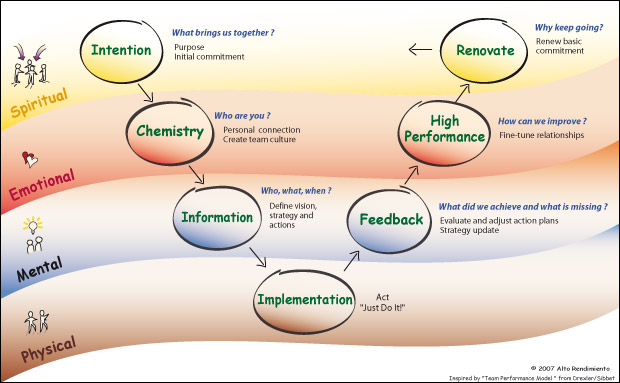| The development of a high performing team follows a specific sequence through different levels of consciousness.
| 1. |
When people get together, they do so with an initial purpose. It is the deeper motive that makes individuals commit to a project. In an organisation it is usually expressed through the Mission statement. |
| 2. |
Once we have decided to embark on a journey together, we need to get to know one another, discover how each person may contribute, understand each other and connect. Our level of personal chemistry determines the quality or our team. |
| 3. |
Once we all know who's on the team, we can focus on our goals: gather information, brainstorm, envision the project and decide on a course of action. This phase will be so much more productive, if we have taken sufficient time to connect as a team. |
| 4. |
Only then are we ready for effective and efficient implementation. |

| 5. |
The confrontation with physical reality produces a wealth of information and experiences, part of which can be dealt with objectively and simply leads to adjustments of our action plans. The key here is continuous quality feedback. |
6. |
The subjective experiences are just as important and valuable. They allow us to fine tune the team dynamic. Victories, mistakes, misunderstandings,... represent a great raw-material to mature our relationships. It's a permanent awareness enhancement and integration of learnings effort (emotional intelligence). |
| 7. |
At some point projects get completed or become obsolete. People periodically need to renew their commitment or have the courage to end and get on with something else. Whatever we do together needs a 100% commitment. |
Dysfunctions arise when we try to skip a phase. Teams often get down to planning business (mental level) without a solid emotional connection. Agreeing on a clear vision and consensing the appropriate action plan then becomes cumbersome and implementation is undermined. Other teams make a good connection, focus well and do good planning, but neglect the follow-up with proper feedback and fine-tuning of their relationships. Others produce great results, yet success is meaningless because the basic focus (mission) and identification with the project hasn’t been renewed.
Good implementation depends on how well the different levels of consciousness get combined: spiritual (intention), emotional (what puts us in motion), mental (structure and focus) and physical (materialise). |







